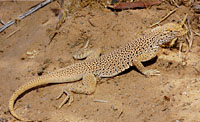Online Field Guide to The Reptiles and Amphibians of Arizona



La Paz County, AZ
 La Paz Co., AZ |
| MOHAVE FRINGE-TOED LIZARD Uma scoparia | |
|
DESCRIPTION: A medium-sized (up to 114 mm or 4.5″ from snout to vent), cream to light tan colored lizard with a relatively flat body and a flattened tail. Coloration usually closely matches the sand on which the lizard lives. The back is marked with small orange spots surrounded by a network of black reticulations. The underside is plain pale cream and becomes tinted with light yellow-green during the breeding season (spring). A conspicuous dark spot marks each side of the belly. The underside of the tail is marked with black crossbars. There are dark, crescent-shaped lines on the throat. This lizard has numerous adaptations for life on fine sand including a fringe of enlarged pointed scales on each hind toe to increase traction, a chisel-shaped snout for burrowing, a countersunk lower jaw, interlocking eyelids, flaps over the ear openings, and valves in the nasal passages to keep sand out of the body. The scales are very small and granular. The crescent-shaped lines on the throat of this lizard, its lack of orange bars on the belly, and its lack of dark lines on the shoulders distinguish it from the similar looking Yuman Fringe-toed Lizard. HABITAT: This sand specialist occupies open dune fields and shrub invaded sand hummocks with at least sporadic, open patches of fine, wind-blown sand. It occurs within the Lower Colorado River subdivision of the Sonoran Desertscrub community. BEHAVIOR: Active during the day. Often encountered basking on the warm sand in the mid-morning sun. Hibernates underground during the cold months of winter and late fall. A speedy, ground-dwelling lizard that runs on its hind limbs at top speeds. When threatened it often runs a short distance and then wriggles under the sand, chisel-shaped snout first. It also uses existing burrows for shelter. DIET: The Mohave Fringe-toed Lizard eats a variety of insects, spiders, and some plant material including flowers and seeds. REPRODUCTION: This lizard mates in spring and lays one or more clutches of eggs in spring and summer. Clutch size ranges from 1 to 5 eggs. Eggs are buried in a shallow moist nest within the sand. By Thomas C. Brennan Brennan, T. C., & A. T. Holycross. 2006. A Field Guide to Amphibians and Reptiles in Arizona. Arizona Game and Fish Department. Phoenix, AZ Stebbins, R.C. 2003. A Field Guide to Western Reptiles and Amphibians, Third Edition. Houghton Mifflin Company, Boston, MA. |
|
Visit Partners in Amphibian and Reptile Conservation:


HOME
Copyright © 2023, Arizona Game and Fish Department. All rights reserved.
If you make use of the textual contents of this site in reports, publications, etc. please cite and credit the author(s) and photographer(s). All photos on this website are copyrighted. However, those found in the species account section may be used for any noncommercial scientific, educational, or conservation purposes provided that photographs are not altered and continue to bear the copyright symbol and name of the photographer. Please contact the photographer regarding commercial use of copyrighted photographs.











